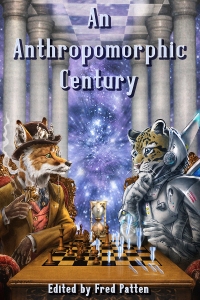Feed aggregator
Patreon hack blamed on furries, news from Culturally F’ed – NEWSDUMP (10/8/15)
What sparked your love for the furry fandom?
Mine would have to be watching shows like sonic and playing games like spyro and starfox
submitted by Furryfoxman[link] [6 comments]
autumn is coming [commission princessrei]
A Furry Short Story
I have been in a bit of a poor state as of late, trouble at home as it were. So, when I am feeling down, I refer to my oldest and reliable set of treatment; writing. If you guys like it I can continue posting the chapters. Please, I always welcome constructive criticism on my writing. I hope you like it!
Part I
The snow blew in drifts across the forest floor as the wind howled across the tall silvery pines. He pulled his fur cloak closer around his body, desperate to keep the wind from seeping between his clothes. It was bitter cold, nothing like he had ever felt, and it bit at his skin even through his thick black winter fur. He wasn’t even wearing much; just his old ridding pants, some leather fastened around his feet as makeshift boots, and of course the fur cloak that he had “acquired” days past from the hunter who was fast asleep. He stopped for a moment, standing in the cold blizzard and snow and thought to himself how much he really hated the fact he had stolen this cloak. That hunter may have needed it, but with that, he reminded himself, he surely needed it more. He shook the conflicting thoughts from his head, pulled the cloak tighter and trudged further through the snow.
The snow was getting high now, it was almost at his waste and the blizzard showed no signs of letting up. He needed to find shelter, and he needed to find it now, lest he freeze to death in this gods forsaken forest. The thought spurred the wolf on a little bit more, yes, shelter is what he needed and a nice fire! It seemed as though there was nothing but snow and pines, pines and snow out here though. He snapped his head to the right, his instincts taking hold, as he heard a crack over his shoulder. The ice and snow was starting to build up on the branches and the tree limbs were starting to break. With his attention towards the snapping branch, he forgot to check his footing and he slipped on an icy rock and tumbled down a bank till he heard a crack and a splash! His whole body, paw to ears was soaking wet. He had fallen in an ice covered creek. Quickly he pulled himself from the frozen waters and drug himself ashore.
His clothes were soaked, his fur was soaked and he was starting to shiver. He wanted to just lay there, he wanted this nightmare to just end. He wanted to just let the winter steal his soul and be done with it, but he was not so easily broken. His iron will had survived much worse, and he would be dammed if he was going to let a little snow and ice break it now. With all his might, he pushed his paws out in front of him, pushing the snow aside and as he began to push himself up, his water logged clothes began to crack as they had already started to freeze. He groaned and growled as the frozen cloak and pants cracked away from his body, snapping off bits of his thick black fur. It was if he was wearing garments made of ice at this point and he knew if he didn’t find shelter in the next few minutes, he would be dead. Even slower than before he pushed himself forwards. One foot forwards into the snow, dragging the other behind him, planting that foot in the icy snow, and dragging the other up behind. Then, just then, he thought he had heard the howl of a bull. He quickly looked around, turning his head from side to side frantically for the sign of life, but he didn’t see anything. He thought to himself that it must be his mind, slowly losing its grip on reality, slipping into the endless madness. He pushed forward again, more carefully this time planting one foot in front of the other, but there it was again, the distinct loud call of a bull. He looked, turning his had side to side and again saw nothing, but then the call came again. His heart burned with the fires of hope and that added hope cracked a cocky grin on his muzzle as he said to himself, “Not today.”
He followed the cries of the bull closer and closer till at last, just outside of the forest he spotted the silhouette of a building. As he got closer he realized that the building was indeed a barn. A fairly decent sized barn he had thought to himself, one probably with cozy warm hay for drying his frozen and soaked clothes and fur. He dragged his frozen body closer and closer till finally he could reach and touch the side of the wooden barn with and outstretched paw. He felt his way to a metal handle and recoiled as the frozen metal felt as if it had burned his paw. He drew both of his paws then in front of his muzzle and blew some warm air from his lungs into his paws, hoping to stay the icy metal for just a moment so he could pull the door open. He grabbed the handle firmly with his icy paws, wincing at the pain of the cold metal and pulled at the barn door, it only groaned under his efforts. This couldn’t be it, he was here, and shelter was inside! He needed to get inside! He cupped his paws in front of his muzzle again and gently blew what felt was the last of his warm breath into them, trying to regain some feeling in the tips of his paw’s digits. Again he winced as he gripped the handle of the door and then, he pulled, and he pulled, and his mustered all of his rage and all of his anger into that door. He remembered being chased from his homeland, his kingdom, by the traitors he had called friends. He remembered his family being sacked and gagged, drug away in the night with nothing he could do. Most of all though, he howled at the thought of the betrayal that had cursed him out into this damned frozen wasteland! With that last thought the door creaked and cracked and groaned as the ice that had frozen it shut had broken away and the barn door slide open. The wolf gave a short sigh of relief before steeping inside and found a nice tall pile of hay to pull himself into.
submitted by KriegVonBeck[link] [comment]
Book of the Month: An Anthropomorphic Century
 October’s Book of the Month, An Anthropomorphic Century, is the latest furry anthology edited by Fred Patten.
October’s Book of the Month, An Anthropomorphic Century, is the latest furry anthology edited by Fred Patten.
What if animals could talk? Or communicate telepathically? What if they evolved to become something more than human, or we made ourselves more like them?
Storytellers have asked these questions from the dawn of human history to the present day. An Anthropomorphic Century showcases the answers to some of these questions from the last century.
Features stories ranging from 1909 to 2008, including the talents of Peter S. Beagle, Philip K. Dick, Michael H. Payne, Phil Geusz, Renee Carter Hall, and more.
Tobermory by Saki
Dr. Lu-mie by Clifton B. Kruse
The Blue Giraffe by L. Sprague de Camp
Barney by Will Stanton
Expendable by Philip K. Dick
The Conspirators by James White
Sic Transit… ? A Shaggy Hairless-Dog Story by Steven Utley and Howard Waldrop
Crow’s Curse by Michael H. Payne
Nine Lives To Live by Sharyn McCrumb
Vole by John Gregory Betancourt
Choice Cuts by Edd Vick
Transmutational Transcontinental by Phil Geusz
Daylight Fading by Chris Hoekstra
The Good Sport by Bill Kieffer
The Dog Said Bow-Wow by Michael Swanwick
Cat ‘n’ Mouse by Steven Millhauser
Pig Paradise by Scott Bradfield
Sergeant Chip by Bradley Denton
Gordon, the Self-Made Cat by Peter S. Beagle
The Wishing Tree by Renee Carter Hall
Cover art by Mark Brill.
Parental rating PG. Available from FurPlanet.
It's there a sub for writers?
Title is self explanatory. Was wondering if there was a sub for the furry writers out there to hang out and bounce ideas around.
submitted by loki_the_sergal[link] [2 comments]
Origins of the feud between Furries and Scalies
There was a little speculation of the origin but I found it in the great big book of Furry Facts. Here is the story.
It was a lovely day in Camelot, England, 1326. The sun was shining despite the rain that had been drizzling the past several days. The air was warm with moisture. It was summertime and the farmers were reaping in the harvest. These products would be used the feed the everyday people in Camelot, and some of it would be used for trade so Camelot would get iron, coal, and thread.
It was these times of peace General Walter liked. The black cat anthro walked into the nearby bakery, smelling the delicious danishes from it.
Meanwhile, Cragtor, another general that was a green scalie, walked into the same bakery. His body was cold-blooded so he needed something to warm up himself. A hot danish would be enough.
Walter stopped at the door and opened it for Cragtor.
"After you,” He said.
"Thank you.” The scalie walked in, then went into the line. So did Walter. The two of them chatted about the war against the Gauls as the line dwindled. Soon, Cragtor got to the counter. He asked for a piping hot strawberry danish and took it from the chef.
Walter went up after Cragtor has paid his fee and asked for the same thing, only to find that Cragor had taken the last one.
The black cat looked at the scalie, eating his danish with delight as he walked out. Walter’s fury grew at the scale. That was supposed to be his danish! He vowed he would never be friends with another scalie again.
About a year later, Walter had kept his promise, sticking only with his mammal kind. Then the king grew sick. Before he died, his successor, for he had no children, was on his tongue. But the lips never formed the name.
And so, another war began. After the generals made a temporary truce to defeat the Gauls, which they did for the time being, they began a war between each one.
Only three managed to rise above the others as they had more money and popularity. They were Walter, Cragtor, and a new comer they ignored, a small smart blue avian by the name of Riner.
Walter kept his wish and declared war against Cragtor with his furry supporters. He vowed the kingdom would only feel the pureness of the furries, and none of the coldness of the scalies. Cragtor attacked back with his scalie, starting a eight year war. The two of them were so focused on their petty squabble, only Riner was worrying about the rest of the kingdom.
The Gauls were coming back, stronger, smarter, and deadlier than ever. Using the avians and the remains of the furries and scalies, Riner defended the kingdom against the Gauls. By using renowned tactics, he was barely able to win against them, but he did. Not only was he victorious, he also had the idea to create a treaty with the Gauls. They had wanted the kingdom due to its great spot for trade. As long as Camelot allowed them to carry out trade, there would be peace.
The rest of the kingdom noticed this and abandoned Walter and Cragtor as their representatives. Riner was now the most liked general and he was crowned in 1345. He ruled the kingdom fairly until he passed his crown to his son, Arthur.
As for Walter and Cragtor, no one knew what happened to them after Riner was kinged. All they knew was that the feud between the furries and scalies still existed. Perhaps they themselves were fueling it. We will never know.
And that’s why I love history.
submitted by topaz_colite[link] [2 comments]
So who are your favorite artists?
I've been an inactive and lazy fur for a long time, and I think it's time to stop lurking and start being active. Who would you recommend to draw/paint my fursona? What advice do you have for the commission process?
submitted by postmodern_cereal[link] [14 comments]
Who are some good furry musicians?
Commission I got from the amazing Falvie!
I need help ;-;
Soo.... Im a furry (obviously) but i went to a mental/aggrestion detention center i tried to tell people im a furry. Most of them that i told didnt even know what a furry is. But the ones that did know, hated them.... So what happened while i was there, i moved to a new town, which means that im gonna go to a new school.. ;-; and now im scared to tell people im a furry because im scared that they will hate me.. What should i do?
submitted by SpeedyDaCat[link] [15 comments]

![autumn is coming [commission princessrei] autumn is coming [commission princessrei]](http://b.thumbs.redditmedia.com/lmqfgUCEdkDsBdr1hJphikAVl6ikG3ZyTuQmNjD3o4w.jpg)







